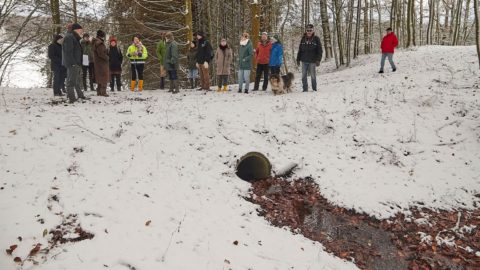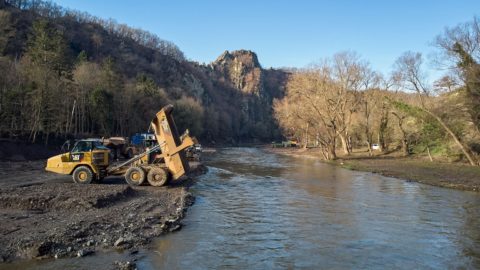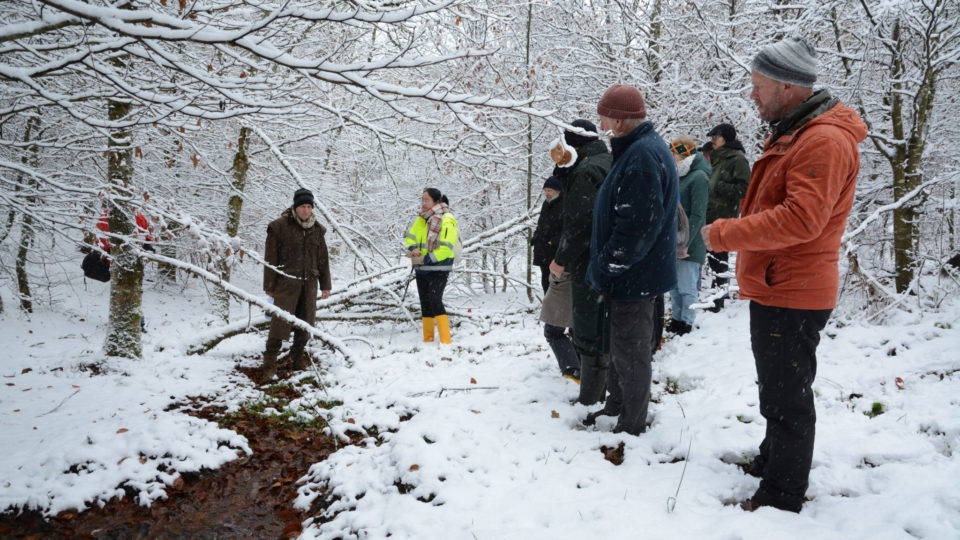How can flood damage be minimised in the future [in the Eifel]? Experts Present Options for Nature-Based Flood Protection in the Euskirchen District
This is an English translation of an article that was originally published in German on the website of https://www.ksta.de/ reporting on an event organised on 29 November by Wetlands International Europe
By Stephan Everling
07.12.2023

The participants of the excursion in the Dommersbach valley learned about options for nature-based flood protection. Copyright: Stephan Everling
It has been almost two and a half years since the night of the floods in the Erft, Urft and Olef catchment area marked a new era in the district of Euskirchen. Since then, life has changed for many. The question of how to prevent a repetition of the flood or at least reduce its consequences has been present ever since.
Apart from the technical structures that are being planned or have already been realised in individual cases as an early measure, there are ways to improve flood protection with natural interventions. The international conference “Nasse Natur – Trockene Füße” (Wet Nature – Dry Feet) provided information on the current developments in this field. The conference was co-organised by Nabu-Kreisverband Euskirchen, Natagora BNVS, Ark Rewilding from the Netherlands and the Life Project Helle Eifeltäler.
Organiser Aldert van Weeren experienced the flood in Blumenthal
The event was organised by Aldert van Weeren. The landscape architect witnessed the disaster in his 300-year-old house in Blumenthal. “The water was 1.98 metres high,” he says. He has since sold the house, but the task of protecting people from losing their belongings in a flood event continues to occupy him. His credo: “When the water is in the valley, it’s too late. We have to stop it before then.”
“When the water is in the valley, it’s too late. We have to stop it before then.” – Aldert van Weeren
He demonstrated several options on an excursion from Ingersberg to the valley of the Schmalebach. This was one of the many small tributaries that flow into the Reifferscheider Bach and contributed to the flood. Van Weeren pointed out many features in the landscape, such as wetlands on meadows that once stored water but disappeared due to the addition of topsoil. And tributaries of the stream coming from the slopes have been channeled into ditches. The Schmalebach also leads in a straight line towards Blumenthal. In earlier times, the path of the water had been twice as long, according to van Weeren.
How transverse tree trunks can hold back water
In total, about a third of the water that ultimately ends up in the Olef could be stopped. However, instead of leaving the structures that the stream has retained in the flood, everything has been dredged away and the Dommersbach has been squeezed back into a narrow channel for rapid drainage. Van Weeren demonstrated how water could be stopped with small interventions: permeable dams could be formed by horizontally lying tree trunks. Under normal circumstances, the water would flow through them.
“The flood accomplishes in twelve hours what expensive projects cannot achieve in twelve years.” – Prof. Dr. Wolfgang Büchs
When the water level rises, it is held back. As the speed and pressure of the water at the top of the mountain are still low, the tree trunks cannot be washed away. According to van Weeren, the tire tracks of the harvesters in the fall line of the slope pose a problem. During heavy rain, these tracks could turn into raging streams, quickly carrying the water downstream. In a narrow valley, it is also easy to construct a retention system with a crossbar, such as a bridge.
Yves Pieper, the forestry office director from Verviers, was also present. Eastern Belgium was also heavily affected by the flood. 39 people died along the Meuse and Weser, and thousands of households were affected. “Many restoration projects are taking place here,” said Pieper. For example, narrow, spruce-lined valleys are being opened up to give the water more space.
Expert criticises post-flood measures along the Ahr
After the practical part, the findings were backed up theoretically with lectures in the Panorama Hall in Vogelsang. Prof Dr Wolfgang Büchs from the University of Hildesheim kicked things off. He has known the Ahr for decades and has published books about the river before and after the flood.

Construction machinery stands on the banks of the river at the Ahr valley bend near Altenahr.]Copyright: dpa/Thomas Frey
The biologist used a series of examples to show how the flood on the Ahr had created natural structures that could help to retain water during the next heavy rainfall: “The flood achieves in twelve hours what expensive projects cannot achieve in twelve years.” However, without the support of nature conservation experts, almost all of the areas where the Ahr and its tributaries had created space had been dismantled.
In many places, for example near Mayschoß, the Ahr has created major scour holes. These were quickly filled in again and built up with standard embankments reinforced with basalt spheres: “If another flood with a peak of up to 1200 cubic metres per second – one cubic metre equals one tonne – rushes through the valley here, these will be the cannonballs of the next flood.”
The Erftverband also includes nature in its plans
Painful groans could be heard from the audience when Büchs showed pictures from the Ahrschleife nature reserve. Here, the flood had piled up large areas of river gravel that could have created new habitats for rare species. However, as these were allegedly contaminated with waste, the responsible authority had the gravel banks excavated using heavy machinery.” 74-tonne heavy machines drove over the sensitive floodplain soils in wet weather,” Büchs said, expressing his disbelief.
He presented a variety of options for nature-based flood protection, such as rows of shrubs that intercept drifting wood and sediment. A system of temporary retention basins at the tributaries of the Ahr, designed back in 1910, could also have prevented a lot of damage, even if it had only been implemented in small parts.
Several experts presented options for nature-based flood protection. Dr. Daniel Bittner from the Erftverband spoke about flood retention basins. “It’s not possible without nature,” he emphasised. Lucia Schmitz and Marietta Schmitz from the Euskirchen Biological Centre also demonstrated ways of keeping water in the landscape. From the Netherlands, Hettie Mertens reported on water retention in the Göhl Valley (Geul Valley in Dutch).
Flood protection
Wetlands International is a foundation that works to restore and preserve moors and wetlands around the world. In connection with the 2021 flood, Aldert van Weeren initiated the project as the “Natural Sponges Coordinator” to develop and promote nature-based flood protection methods.

